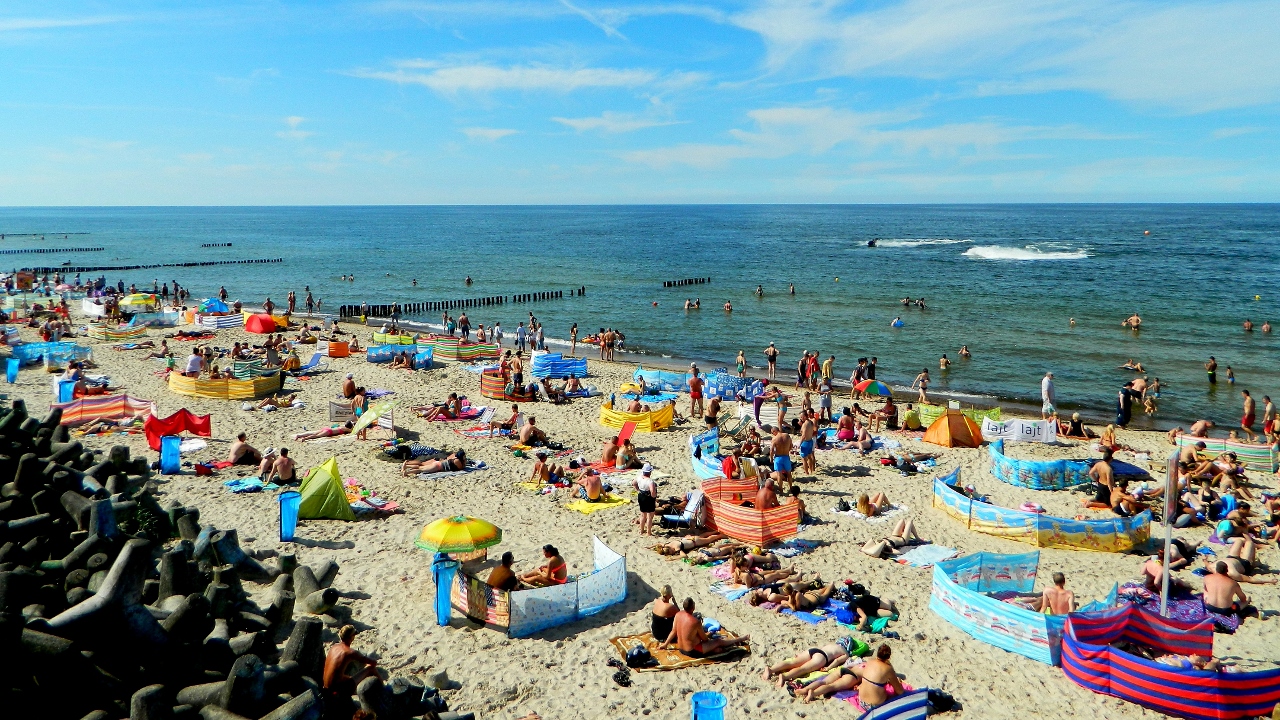The sixty mile drive north to the Polish Baltic Coast took nearly four hours, being subject again to heavily monitored speed restrictions and, in places, very poor road conditions and diversions. No matter, it meant time to enjoy the scenery as we moved in a single file of port and beach-bound heavy freight and heavily-laden holiday makers’ cars across the fertile, rich plains.
Farmers on ancient looking tractors busily harvested fields and the sun flashed strobe-like as we passed through the shadows cast by roadside forests of tall pine trees.

Polish beaches, after German counterparts, were a revelation of familiarity. Gone were the quiet strandkorbe-lined and orderly enjoyment of the sunshine and sea, here was the noisy frivolity and colourful chaos of a British bank holiday in Brighton.
Beach hawkers yodelled about popcorn, coffee and cigarettes and sold their wares to a haphazard but cheerful crowd lying on makeshift towels on the sand. It was noisy. Small dogs in baskets yapped, babies in hampers howled. Music blared from portable speakers. It was a world away from the sophisticated pleasures of the German Baltic resorts but touchingly more recognisable to us as ‘a day on the beach’.
So… into the sea at Mielno. Images of inky black and broiling Baltic swells of the imagination dissipated in sight of sparkling white crests of waves rolling under the impossibly clear northern light. I braved the cold shallows, surprised at their chill as I now expected luxurious Mediterranean warmth, and then dived into the blue depths and saw… jelly fish.
Swarms of white and pink gelatinous tendrils reached up to me as I hastened my front crawl back to the shore to join the legions of paddling Poles, at close hand now seen to be guzzling from bottles of beer and spirits. Shoeless, I dodged serrated beer bottle tops and discarded cigarettes, still-burning on an otherwise picturesque white sand.

At Łeba, we cycled into the Słowiński national park under a blazing sky and climbed with heavy legs up the side of the Łącka dune.
Once again the clarity of the pure northern light played on the senses and presented a flat one-dimensional – almost stage-lit – image in need of some recognisable form in the foreground to give it scale. A small dog yapped in a basket and a large group of Karate kids showed the enormity of the 42 metre high and shifting mass of sand that had swallowed the original village of Łeba.
We cycled through the woods to a site where rockets were tested both by the Germans during the war and by the Polish forces after 1945. It was a chilling sight to be confronted with a V2 rocket, of the sort which bombarded London, looming large and sinister among the trees.
In the late afternoon somnambulance of Wladyslawowo we visited the strange concrete pyramid of the town’s Catholic Church. The gigantic triangular stained glass windows sent a kaleidoscope of psychedelic colours across the traditional wooden pews where a crowd of youngsters had gathered.
Suddenly a tiny bell rang, gowned priests and alter-boys entered and the young voices soared into a beautiful melody of harmony accompanied by a single guitar. It was mesmerising. Poland has remained a staunchly Catholic country and has credited its collective faith, and the inspiration of its own Cardinal of Krakow, Pope John Paul II, for its resistance and ultimate triumph over communism.
The next morning, Sunday, we cycled past the same church where hundreds were packed outside to hear the sung mass over loud speakers. It was a public demonstration of belief, and as we were later to learn in Gdansk, solidarity.
Heading south to the Polish ‘Riviera’ we camped at Sopot, part of the ‘tri-city’ together with the port of Gdynia and the historic Hanseatic city of Gdańsk (Danzig). Well-dressed locals and tourists strolled along the Molo, Europe’s longest wooden pier.
Looking back at the shore, Hitler’s first floor suite of rooms at the Grand Hotel Sopot was easily identifiable with its opened floor-to-ceiling windows. From here, he is said to have watched the Nazi’s attack on the Polish occupied Westerplatte Peninsular, contributing to the invasion of Poland and plunging Europe once again into global war for the second time in the 20th century.

All is now quiet, peaceful and high-end consumerism. Champagne, Prosecco and Martini bars line the sandy boulevard and well-heeled holiday makers lounge in white curtained four poster beds on the strand. Swiss watches, Porches and the latest VW Golf models are all heavily advertised. MacDonald’s, KFC, Subway, Starbucks and even good old Costa line the manicured garden walkway into town from the beach.
Part of the EU since the early 2000s Poland still jealously guards its currency, the Złoty, whilst being part of the single market and enjoying freedom of movement across the member states. A very recent report by the BBC showed that the largest non UK- country of birth for people living in the UK is now Poland, outstripping India as the historical magnet of immigration.
Perhaps, not surprisingly, we heard English, American and Asian voices around us for the first time since leaving Holland.

Here’s a gallery of our time along the Polish Baltic coast:
































